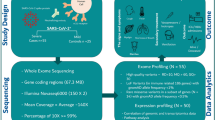Abstract
Vibrio cholerae causes a dehydrating diarrheal illness that can be rapidly fatal in the absence of specific treatment. The organism is an historic scourge and, like similar infectious diseases, may have influenced the evolution of the human genome. We report here the results of the first candidate gene association study of cholera. In a family-based study of 76 pedigrees from Dhaka, Bangladesh, we evaluated the association between cholera and five candidate genes—the cystic fibrosis transmembrane receptor; lactoferrin; long palate, lung and nasal epithelium clone 1 (LPLUNC1); estrogen-related receptor alpha and calcium-activated chloride channel 1. We found a significant association with a marker in the promoter region of LPLUNC1 (rs11906665), a member of a family of evolutionarily conserved innate immunity proteins. An earlier microarray-based study of duodenal biopsies showed significantly increased expression of LPLUNC1 in cholera patients compared with healthy control subjects. Our results suggest that variation in host innate immune responses may influence the outcome of exposure to V. cholerae in an endemic setting.
This is a preview of subscription content, access via your institution
Access options
Subscribe to this journal
Receive 6 digital issues and online access to articles
$119.00 per year
only $19.83 per issue
Buy this article
- Purchase on Springer Link
- Instant access to full article PDF
Prices may be subject to local taxes which are calculated during checkout

Similar content being viewed by others
References
Glass RI, Holmgren J, Haley CE, Khan MR, Svennerholm AM, Stoll BJ et al. Predisposition for cholera of individuals with O blood group: possible evolutionary significance. Am J Epidemiol 1985; 121: 791–796.
Mourant AE . Blood Relations: Blood Groups and Anthropology. Oxford University Press: London, 1983.
Harris JB, LaRocque RC, Chowdhury F, Khan AI, Logvinenko T, Faruque AS et al. Susceptibility to Vibrio cholerae infection in a cohort of household contacts of patients with cholera in Bangladesh. PLoS Negl Trop Dis 2008; 2: e221.
Gabriel SE, Brigman KN, Koller BH, Boucher RC, Stutts MJ . Cystic fibrosis heterozygote resistance to cholera toxin in the cystic fibrosis mouse model. Science 1994; 266: 107–109.
Rodman DM, Zamudio S . The cystic fibrosis heterozygote—advantage in surviving cholera? Med Hypotheses 1991; 36: 253–258.
Flach CF, Qadri F, Bhuiyan TR, Alam NH, Jennische E, Lonnroth I et al. Broad up-regulation of innate defense factors during acute cholera. Infect Immun 2007; 75: 2343–2350.
Zhou HD, Li XL, Li GY, Zhou M, Liu HY, Yang YX et al. Effect of SPLUNC1 protein on the Pseudomonas aeruginosa and Epstein-Barr virus. Mol Cell Biochem 2008; 309: 191–197.
Petri Jr WA, Miller M, Binder HJ, Levine MM, Dillingham R, Guerrant RL . Enteric infections, diarrhea, and their impact on function and development. J Clin Invest 2008; 118: 1277–1290.
Mohamed JA, DuPont HL, Jiang ZD, Belkind-Gerson J, Figueroa JF, Armitige LY et al. A novel single-nucleotide polymorphism in the lactoferrin gene is associated with susceptibility to diarrhea in North American travelers to Mexico. Clin Infect Dis 2007; 44: 945–952.
Saha D, LaRocque RC, Khan AI, Harris JB, Begum YA, Akramuzzaman SM et al. Incomplete correlation of serum vibriocidal antibody titer with protection from Vibrio cholerae infection in urban Bangladesh. J Infect Dis 2004; 189: 2318–2322.
de Bakker PI, Yelensky R, Pe'er I, Gabriel SB, Daly MJ, Altshuler D . Efficiency and power in genetic association studies. Nat Genet 2005; 37: 1217–1223.
Barrett JC, Fry B, Maller J, Daly MJ . Haploview: analysis and visualization of LD and haplotype maps. Bioinformatics 2005; 21: 263–265.
Acknowledgements
We thank Cherylyn Smith and Liuda Ziagra of the Broad Institute for their work on the genotyping. We are grateful to Elinor Karlsson for a critical reading of the paper. This research was supported by a Claflin Distinguished Scholar Award from the Massachusetts General Hospital (RCL), K01-TW07144 from the Fogarty International Center (RCL), a Physician Scientist Early Career Award from the Howard Hughes Medical Institute (RCL), the Intramural Program of the National Human Genome Research Institute of the NIH (PD), K01-TW07409 from the Fogarty International Center (JBH), U01-AI58935 from the National Institute of Allergy and Infectious Diseases (SBC), U01-AI077883 from the National Institute of Allergy and Infectious Diseases (ETR), R03-AI063079 from the National Institute of Allergy and Infectious Diseases (FQ) and the International Centre for Diarrhoeal Disease Research, Dhaka, Bangladesh (FQ).
Author information
Authors and Affiliations
Corresponding author
Additional information
Supplementary information accompanies the paper on Genes and Immunity website (http://www.nature.com/gene)
Supplementary information
Rights and permissions
About this article
Cite this article
LaRocque, R., Sabeti, P., Duggal, P. et al. A variant in long palate, lung and nasal epithelium clone 1 is associated with cholera in a Bangladeshi population. Genes Immun 10, 267–272 (2009). https://doi.org/10.1038/gene.2009.2
Received:
Revised:
Accepted:
Published:
Issue Date:
DOI: https://doi.org/10.1038/gene.2009.2
Keywords
This article is cited by
-
Assessment of the influence of ABO blood groups on oral cholera vaccine immunogenicity in a cholera endemic area in Zambia
BMC Public Health (2023)
-
Genomic correlates of variability in immune response to an oral cholera vaccine
European Journal of Human Genetics (2013)
-
Cholera: Lessons from Haiti and Beyond
Current Infectious Disease Reports (2012)
-
Cholera transmission: the host, pathogen and bacteriophage dynamic
Nature Reviews Microbiology (2009)



